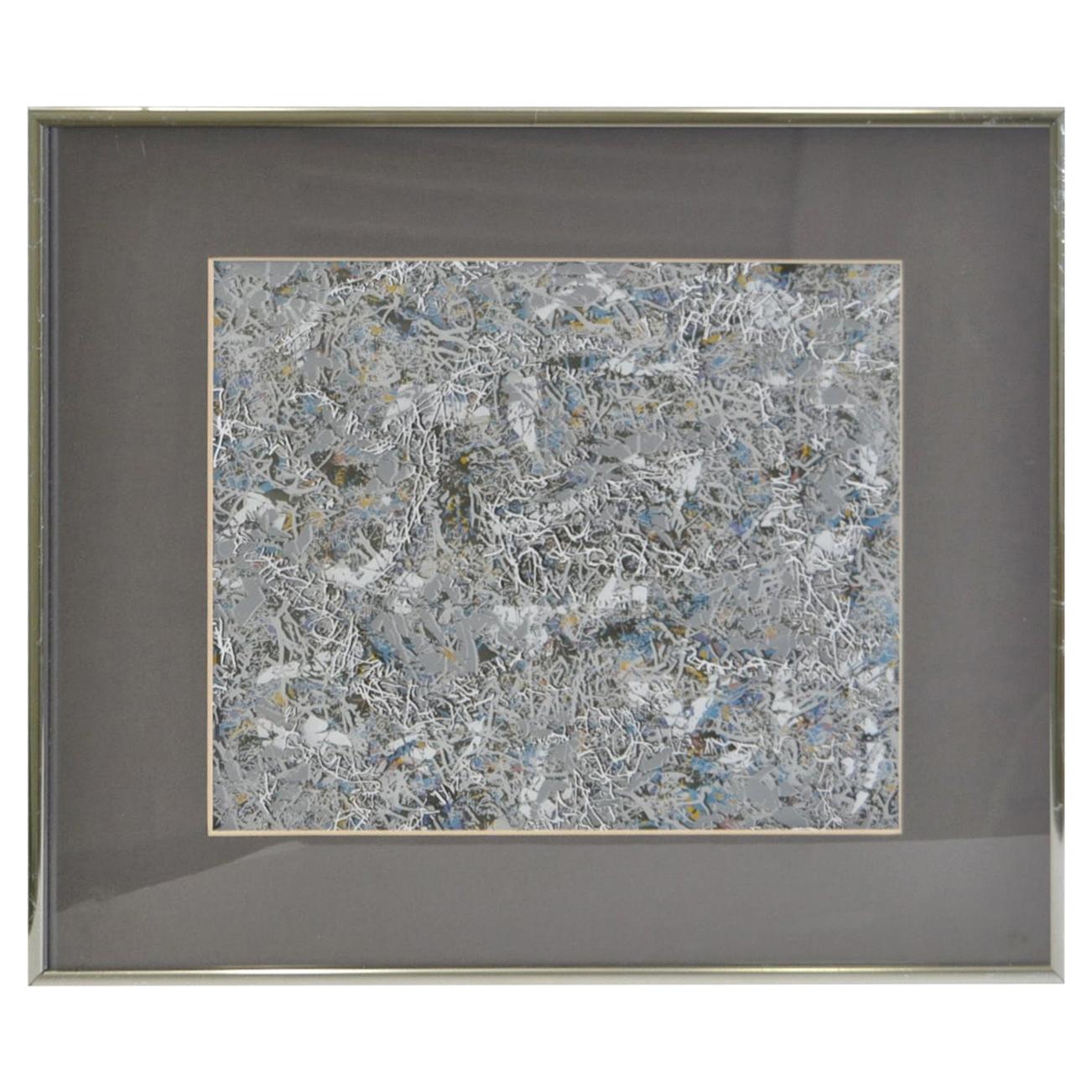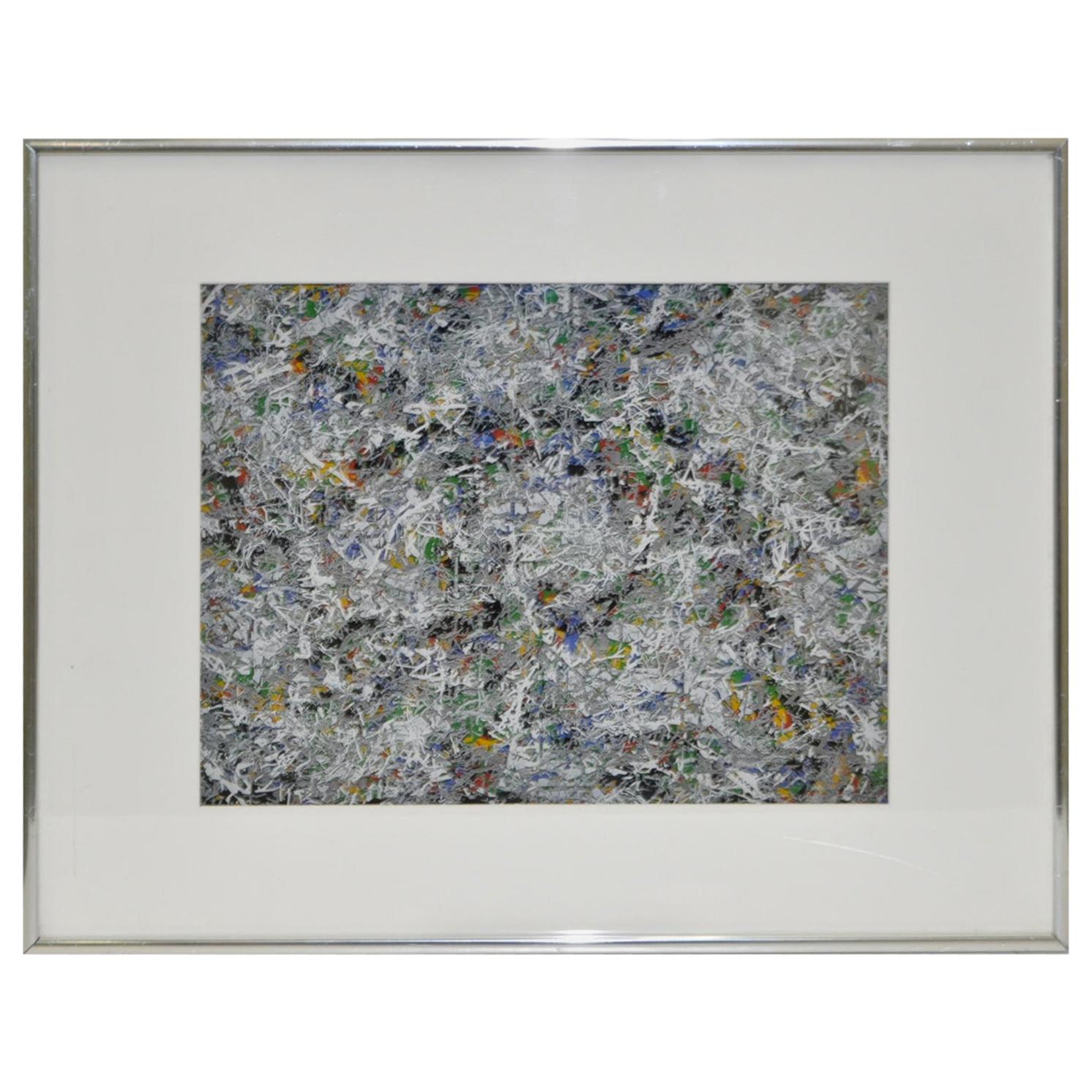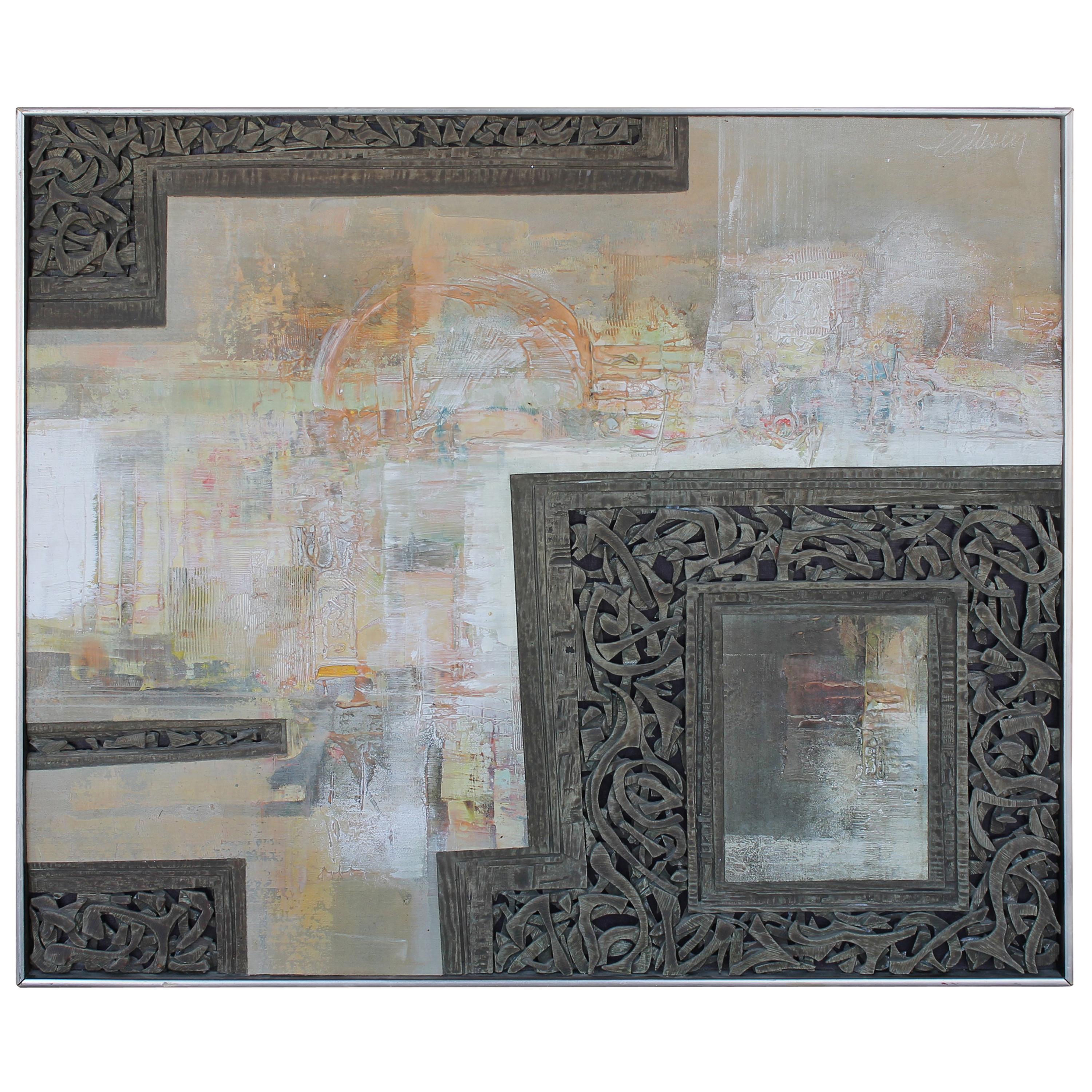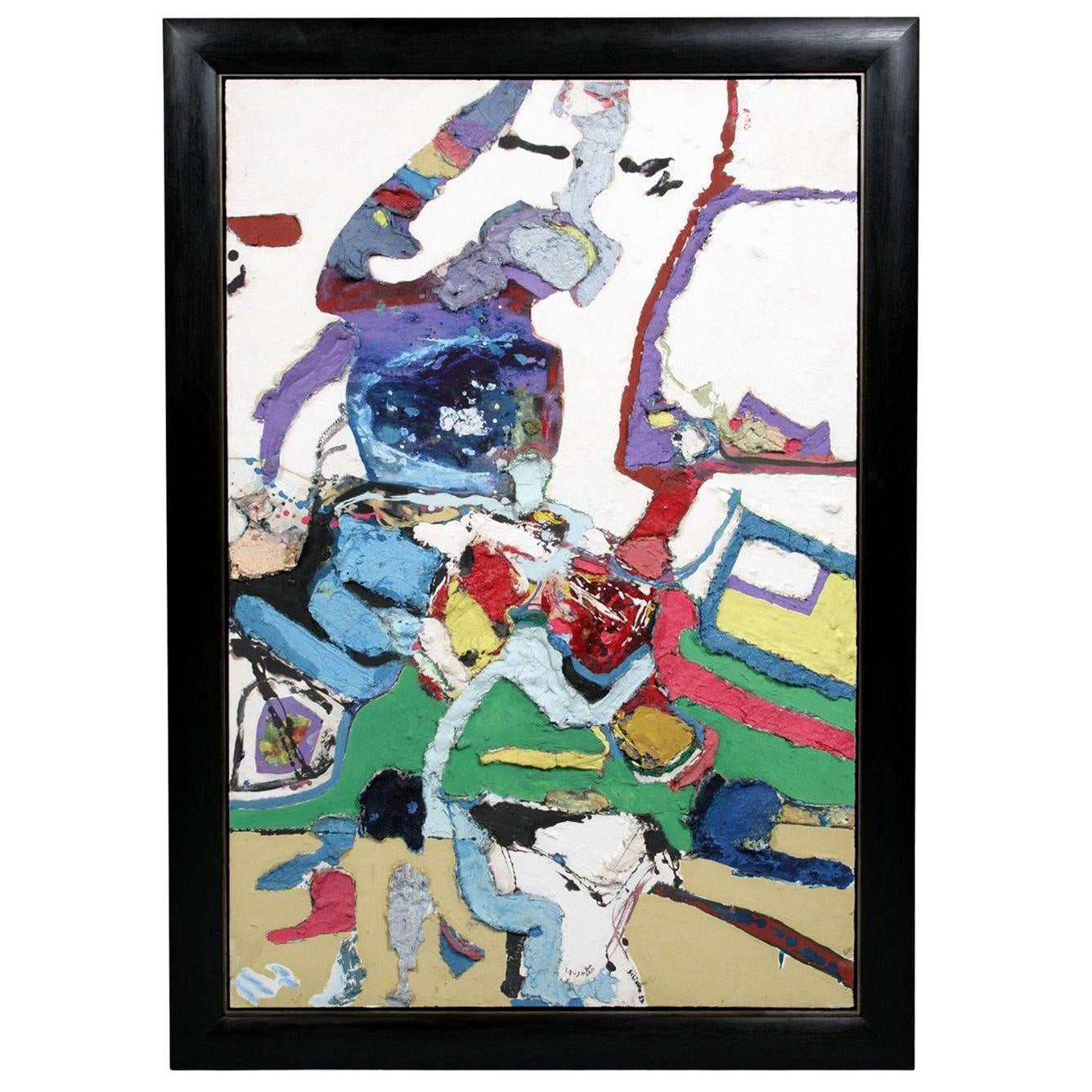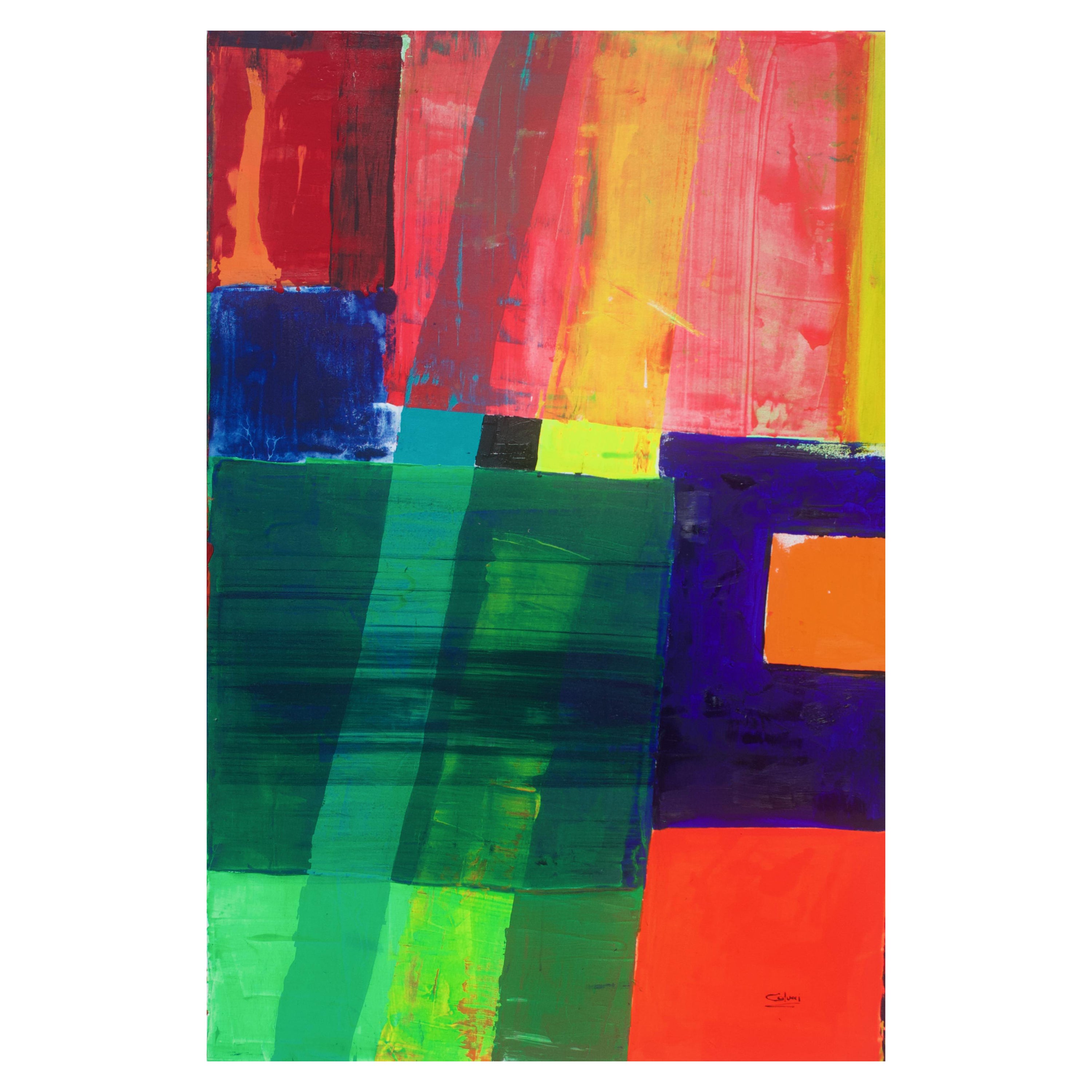Items Similar to "U.S. Flag Behind Capitol" by Ron Sloan, Mixed Media Painting, 1985
Want more images or videos?
Request additional images or videos from the seller
1 of 6
"U.S. Flag Behind Capitol" by Ron Sloan, Mixed Media Painting, 1985
About the Item
Presented is “U.S. Flag Behind Capitol,” an original mixed-media painting by American artist Ron Sloan. The drawing shows an intricately detailed rendering of the front entrance to the United States Capitol building. Behind the Capitol is a large, waving American flag, set outside an orange-hued rounded rectangle. Sloan created this stunning artwork in February of 1985, for use on the Fleetwood First Day Cover of the 22 cent “Flag Over Capitol” stamp, issued in March of that same year.
The painting depicts the iconic neoclassical building from the east orientation, with it’s dome towering overhead. Plans began in May of 1854 to build a new cast-iron dome for the United States Capitol. The then-architect of the Capitol Thomas Walter and his team were sold on the aesthetics of a new dome, as well as the utility of a fire-proof one. A year later, on March 3, 1855, President Franklin Pierce signed off on the appropriation of $100,000 to build the dome. Construction began in September of that year with the removal of the first dome raised by Charles Bulfinch. Over the next 11 years, the dome rose over the nation's capital.
By December of 1863, Walter was able to set the bronze sculpture “Statue of Freedom” atop the dome. Thomas Walter resigned in 1865 and his replacement, Edward Clark, assumed the role of finishing the last aspects of the dome. Just over a month later, in January 1866, Constantino Brumidi, who had been hired to paint a fresco above the interior dome's oculus, removed the scaffolding used during his work on the Apotheosis of Washington. This signaled the end of construction for the United States Capitol dome.
A First Day Cover consists of an envelope and a stamp tied together by a theme, usually celebrating a historic moment or historical figure. Very collectible, First Day Covers feature a stamp canceled on its first day of issue and a large artistic cachet that usually fills most of the envelope. The artistry that goes into these envelopes is very impressive, as they have to celebrate a moment in history and compliment the art on the stamp. Fleetwood First Day Covers are produced for both commemorative and regular issue U.S. stamps of all denominations.
CONDITION:
Mixed- media painting on illustration board. Colors are vibrant. Signed in lower right of composition. Verso is stamped with several past collection stamps, including Unilever Corporation reference numbers and registrar information. Unframed. Image size: 17 1/2” H x 16 1/4”W. Paper size: 25 1/2” H x 19 3/4” W.
- Dimensions:Height: 25.5 in (64.77 cm)Width: 19.75 in (50.17 cm)Depth: 0.25 in (6.35 mm)
- Materials and Techniques:
- Place of Origin:
- Period:1980-1989
- Date of Manufacture:1985
- Condition:Wear consistent with age and use.
- Seller Location:Colorado Springs, CO
- Reference Number:
About the Seller
4.9
Platinum Seller
These expertly vetted sellers are 1stDibs' most experienced sellers and are rated highest by our customers.
Established in 2010
1stDibs seller since 2011
400 sales on 1stDibs
Typical response time: <1 hour
- ShippingRetrieving quote...Ships From: Colorado Springs, CO
- Return PolicyA return for this item may be initiated within 10 days of delivery.
More From This SellerView All
- "North American B-25B Mitchell Airplane" by Steve Ferguson, Mixed Media PaintingLocated in Colorado Springs, COPresented is an original mixed media painting by Steve Ferguson, entitled North American B-25B Mitchell Airplane. The work was painted for use on the Fleetw...Category
Late 20th Century Paintings
MaterialsPaint
- Solheim Cup Matches U.S. & European Team Signed Photo & Flag, 2009Located in Colorado Springs, COPresented is an autographed collage celebrating the women golfers of the 2009 Solheim Cup U.S. and European teams. The 11th Solheim Cup Matches were held Au...Category
Early 2000s American Sports Equipment and Memorabilia
MaterialsFabric, Paper
- "Legends of the West-Indian Chief" by Chris Calle, Mixed Media PaintingLocated in Colorado Springs, COPresented is the original mixed media illustration of "Legends of the West - Indian Chief" by Chris Calle. The vibrant illustration features a head and shoulders portrait of a Native American chief. The chief is wearing an elaborate feathered and beaded headdress. Chris Calle painted...Category
1990s Paintings
MaterialsPaint
- Solheim Cup Matches U.S. & European Team Signed Photo & Flag, Circa 2009Located in Colorado Springs, COSolheim Cup Matches U.S. & European Team Signed Photo & Flag, USA 16 vs. EUROPE 12, Circa 2009 Presented is an autographed collage celebrating the women golfers...Category
Early 2000s Sports Equipment and Memorabilia
MaterialsPaper
- "Defiant Comanche" Mixed Media Sculpture by Chris PardellLocated in Colorado Springs, COPresented is an original mixed-media sculpture by Christopher Pardell, called "Defiant Comanche". The sculpture was produced in a limited edition by Legends, as number 167 of 950. The sculpture features the bust of Defiant Comanche Quanah Parker and was produced in 1991. The sculpture features the artist's signature "C.A. Pradell" in yellow ink on the font of the base, as well as an inscription of the artist's name on the back of the figure's sash. Quanah Parker was a war leader of the Quahadi band of the Comanche Nation and a prominent figure in the Red River War. Quanah Parker was never elected chief by his people but was appointed by the federal government as principal chief of the entire Comanche Nation. He became a primary emissary of southwest indigenous Americans to the United States legislature. Christopher Pardell began sculpting at young age. Influenced by the work of renowned sculptors Russell, Remington, and Rodin, Pardell wanted to pursue his passion for realism. His formal education was laid aside in favor of an apprentice mold maker position with a statuary company. As an apprentice to the Italian master artisans who ran the statuary, Christopher rapidly learned the skills that would enable him to excel as an artist and earn the stature that has come with his success. Never sketching his designs on paper, Christopher composes all of his work in three dimensions, in a marquette. This unique approach explains the unparalleled beauty and detail that are the trademarks of his work. Christopher's exceptional style and special talent have served to impress even the most discriminating collector. The sense of tragedy and drama of the Native American has long been an artistic theme of his. "I try to convey the spirit behind the Native American lifestyle. The sculptural nature of Native American dress...Category
1990s Sculptures and Carvings
MaterialsBronze, Copper, Pewter
- Vintage WWII U.S. Navy Patriotic Banner, "Welcome Firemen" Flag, circa 1941-1945Located in Colorado Springs, COThis is a beautifully preserved WWII Navy aircraft carrier banner, emblazoned with a welcome for the ship's firemen. The banner is partially printed and has sewn elements. The flag's field is dyed a rich navy blue, with a resist dyed white stripe and a sewn red stripe at both top and bottom. A large "WELCOME" is resist dyed at center, in big white letters. This is followed by a sewn yellow strip of contrasting fabric, printed with the word "FIREMEN" in blue. Thirteen white stars complete the design of this patriotic piece of WWII and Navy history. The banner retains its original white hoist, with two metal grommets on each side, for ease in display on the ship. Along the center of the hoist is the printed name of "J.S. Sullivan." "Naugatuck, Conn." is printed along the left and the size "2 x3 FT" is printed along the right. The flag maker, Annin, has sewn in its label, boasting "guaranteed defiance fast colors." CONDITION: Very good condition, considering age and past use. Partially printed and hand-sewn flag construction. Some toning to the white of the flag and along the top hoist. Original grommets at left and right of the hoist. The flag measures 36" X 22". Expertly framed on black linen with an antiqued black wood...Category
Vintage 1940s American Political and Patriotic Memorabilia
MaterialsLinen
You May Also Like
- Paul Slapion, Mixed-Media Abstract Painting, circa 1985Located in San Francisco, CAPaul Slapion (American, 20th century) mixed-media abstract painting Title: In Each of Us...All of Us #10 circa 1985 A fine mixed-media painting created with many layers of glass, ink and oils. Visually stunning optical art. Dimensions 16 inches x 20 inches. Frame dimensions 20.25 inches x 16.25 inches. Very good vintage condition. Lightly distressed frame. Signed verso with the original "OK Harris Gallery...Category
Late 20th Century American Modern Paintings
MaterialsGlass, Paint
- Paul Slapion, Mixed-Media Abstract Painting, circa 1985Located in San Francisco, CAPaul Slapion (American, 20th century) mixed-media abstract painting Title: In Each of Us...All of Us #4 circa 1985 A fine mixed media painting created with many layers of glass, ink and oils. Visually stunning optical art. Dimensions 16 inches x 20 inches. Frame dimensions 20.25 inches x 16.25 inches. Very good vintage condition. Lightly distressed frame. Signed verso with the original "OK Harris Gallery...Category
Late 20th Century American Modern Paintings
MaterialsGlass, Paint
- Mixed-Media Painting by Don ClausenBy Don ClausenLocated in Palm Springs, CAMixed-media painting by Don Clausen (1930 - ), dated 1971. Painting is on wood. Don Clausen is/was active in California and is known for abstract expression. He uses a palette knife ...Category
Vintage 1970s American Paintings
MaterialsWood
- Mixed-Media Painting by Louis SchiavoBy Louis SchiavoLocated in London, GBMixed-media on board on gesso ground, in gouache and oil using the impasto technique. The work also includes areas of collage using applied materials beneath the paint to add depth ...Category
Vintage 1950s Corsican Mid-Century Modern Paintings
MaterialsCanvas
- Mixed Media Painting by Steven ColucciBy John ByardLocated in New York City, NYSteven Colucci’s iconoclastic approach to performance and the visual arts have not only long blurred the boundaries between these disciplines, but have challenged its most basic assumptions. The title of this show references a most rudimentary dance move --the plié --and our assumptions of what to expect in relation to this. Also the suggestion that we can simply press a button and a preconceived outcome will be courteously delivered --a form of prefabricated belief in itself. Steven Colucci’s artwork turns such basic assumptions on their heads. Finding early inspiration in the New York school of abstract expressionists such as Jackson Pollock with his action painting, and then further by his professor --a then young Vito Acconci while studying at the School of Visual Arts, Steven Colucci went from exploring the raw existentialist experimentation of New York’s early painting and performance scenes, to investigating the other end of the spectrum --the rigorously measured and controlled disciplines of pantomime and ballet; studying in Paris under the tutelage of world-famous Marcelle Marceau, and engaging with the concepts of dramatic movement pioneer and intellectual Etienne Decroux. Colucci has explained the difference between the extremes of pantomime and dance as being that pantomime forces movement via an internal capacity --movement directed inward to the core of one’s self --a source requiring extreme mental and physical control. Dance by contrast is an external expression; likewise requiring great precision, although instead an extension of self or sentiment that projects outwardly. While such historical ‘movement’ disciplines serve as foundation blocks for Steven’s artistic explorations, it is the realm in between that he is best known for his contributions --an experimental movement and performance art that simultaneously honors, yet defiantly refutes tradition; rejecting a compartmentalization regarding art and movement, yet incorporating its elements into his own brand of experimental pastiche. Colucci’s performance works manifest as eerily candy-coated and familiar, yet incorporate unexpected jags of the uncanny throughout, exploiting a sort of coulrophobia in the viewer; an exploration of a cumulative artifice that binds human nature against its darker tendencies; highlighting traditions of artifice itself - the fabricated systemologies that necessitate compartmentalization in the first place. It is evident in Steven Colucci’s paintings that he has established a uniquely distinctive pictorial vocabulary; a strong allusion to --or moreso an extension of --his performance works. Colucci’s paintings depict a sort of kinetic spectrum, or as he refers to them “a technical expression of physicality and movement”. Whereas the French performance and visual artist Yves Klein used the human body as a “paint brush” to demarcate his paintings and thereby signify a residue of performance, Colucci’s utilization of nonsensical numbers and number sequences taken from dance scores, as well as heat- induced image abstraction depicting traces of movement likewise inform his vocabulary. In the strand of the choreographed, yet incorporating moments of chance, Colucci’s paintings represent an over arching structure; a rhythm of being and state, yet detail erratic moments --moments that denote a certain frailty --the edge of human stamina. Colucci’s paintings dually represent a form of gestural abstraction --and also the reverse of this --a unique anthropomorphization of varying states of movement – that sometimes present as a temperature induced color field, at others are juxtapositions of movement and depictions of physical gestural images themselves. Colucci’s use of vernacular and found materials such as cardboard evoke his mastery of set design, and also reference a sort of collective experience of urbanity and the ephemeral. Such contradictions seem to permeate not only Steven Colucci’s artwork, but also are reflected in his person – one who grew up in New York’s Bronx during a zeitgeist moment in visual and performing arts in the 1960s – one who shifts with ease from happenings and experiments in New York City, to his meticulously choreographed megaproductions at Lincoln Center or starring in the Paris ballet...Category
2010s Paintings
MaterialsAcrylic
- Mixed Media Painting by Steven ColucciBy Jackson PollockLocated in New York City, NYSteven Colucci’s iconoclastic approach to performance and the visual arts have not only long blurred the boundaries between these disciplines, but have challenged its most basic assumptions. The title of this show references a most rudimentary dance move --the plié --and our assumptions of what to expect in relation to this. Also the suggestion that we can simply press a button and a preconceived outcome will be courteously delivered --a form of prefabricated belief in itself. Steven Colucci’s artwork turns such basic assumptions on their heads. Finding early inspiration in the New York school of abstract expressionists such as Jackson Pollock with his action painting, and then further by his professor --a then young Vito Acconci while studying at the School of Visual Arts, Steven Colucci went from exploring the raw existentialist experimentation of New York’s early painting and performance scenes, to investigating the other end of the spectrum --the rigorously measured and controlled disciplines of pantomime and ballet; studying in Paris under the tutelage of world-famous Marcelle Marceau, and engaging with the concepts of dramatic movement pioneer and intellectual Etienne Decroux. Colucci has explained the difference between the extremes of pantomime and dance as being that pantomime forces movement via an internal capacity --movement directed inward to the core of one’s self --a source requiring extreme mental and physical control. Dance by contrast is an external expression; likewise requiring great precision, although instead an extension of self or sentiment that projects outwardly. While such historical ‘movement’ disciplines serve as foundation blocks for Steven’s artistic explorations, it is the realm in between that he is best known for his contributions --an experimental movement and performance art that simultaneously honors, yet defiantly refutes tradition; rejecting a compartmentalization regarding art and movement, yet incorporating its elements into his own brand of experimental pastiche. Colucci’s performance works manifest as eerily candy-coated and familiar, yet incorporate unexpected jags of the uncanny throughout, exploiting a sort of coulrophobia in the viewer; an exploration of a cumulative artifice that binds human nature against its darker tendencies; highlighting traditions of artifice itself - the fabricated systemologies that necessitate compartmentalization in the first place. It is evident in Steven Colucci’s paintings that he has established a uniquely distinctive pictorial vocabulary; a strong allusion to --or moreso an extension of --his performance works. Colucci’s paintings depict a sort of kinetic spectrum, or as he refers to them “a technical expression of physicality and movement”. Whereas the French performance and visual artist Yves Klein used the human body as a “paint brush” to demarcate his paintings and thereby signify a residue of performance, Colucci’s utilization of nonsensical numbers and number sequences taken from dance scores, as well as heat- induced image abstraction depicting traces of movement likewise inform his vocabulary. In the strand of the choreographed, yet incorporating moments of chance, Colucci’s paintings represent an over arching structure; a rhythm of being and state, yet detail erratic moments --moments that denote a certain frailty --the edge of human stamina. Colucci’s paintings dually represent a form of gestural abstraction --and also the reverse of this --a unique anthropomorphization of varying states of movement – that sometimes present as a temperature induced color field, at others are juxtapositions of movement and depictions of physical gestural images themselves. Colucci’s use of vernacular and found materials such as cardboard evoke his mastery of set design, and also reference a sort of collective experience of urbanity and the ephemeral. Such contradictions seem to permeate not only Steven Colucci’s artwork, but also are reflected in his person – one who grew up in New York’s Bronx during a zeitgeist moment in visual and performing arts in the 1960s – one who shifts with ease from happenings and experiments in New York City, to his meticulously choreographed megaproductions at Lincoln Center or starring in the Paris ballet...Category
2010s Paintings
MaterialsAcrylic
